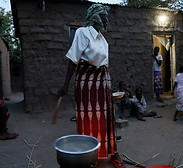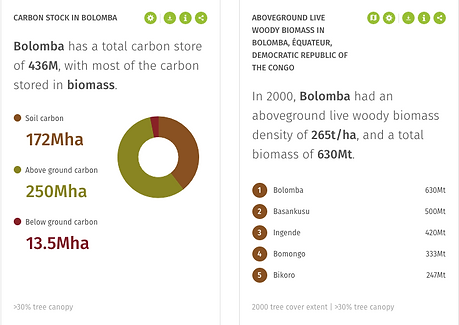
THE REDD+ PROJECT
The Bolomba & Ingende REDD+ is one of the first REDD+ Projects in the Democratic Republic of the Congo (DRC) supported by the Congolese government and other international organizations. Located in the north of the second largest rainforest in the world (the Congo Basin), the Bolomba & Ingende project protects approximately 493,568 hectares of forest while providing much needed infrastructure and land use services to local communities.
The volume of tons to be issued estimated: 100 million tCO2e total with the average over the life of the project (25 years) at 4M tCO2e estimated per year.
Local communities and the Ministry of Environment are included from the initial planning of the project - which is about to be validated to the Climate, Community and Biodiversity (CCBA) and the Verified Carbon Standards (VCS).
The project area - with its dense rain and swamp forest in the northern province of Equateur – is the natural habitat for chimpanzees, bonobos, different types of birds and forest elephants. Protecting this area includes protecting wildlife, watersheds, and its healthy soils. Beyond the direct climate benefits, the project conserves ecosystem integrity, healthy soils, watersheds, and wildlife habitat.
The rainforest is a home, a habitat, a shelter, a pharmacy, a supermarket and an ecosystem that supports many lives and livelihoods. The project area is also home to more than 500,000 people living in 400 villages, who make a living from fishing, shifting cultivation and charcoal production. We work closely with local communities to facilitate community-based conservation and agricultural enhancement. In addition, several socioeconomic benefits will result from project activities including: building schools, medical clinics, vaccination programs, clean energy facility, school supply distribution and capacity building workshops for employees and project area communities. Revenues from the sale of carbon credits will be channeled directly into the project region. A “Local Development Fund” will be managed by a committee of villagers who will decide on how the income will be spent on activities in their communities.
DID YOU KNOW THAT:
-
EVERY 2 SECONDS, WE LOSE AN AREA OF RAINFOREST THE SIZE OF A FOOTBALL PITCH
-
DEFORESTATION AND FOREST DEGRADATION ACCOUNTS FOR AROUND 10% OF GLOBAL GREENHOUSE GAS EMISSIONS
-
THE CONGO BASIN RAINFOREST IS A UNIQUE HOME TO MANY ENDANGERED AND THREATENED ANIMAL SPECIES, INCLUDING THE OKAPI, THE BONOBO AND THE FOREST ELEPHANT
-
ILLEGAL LOGGING COSTS THE WORLD $26 BILLION EACH YEAR. IN AFRICA, LOSSES FROM ACTIVITIES LIKE ILLEGAL LOGGING ARE TWICE AS LARGE AS INTERNATIONAL AID RECEIPTS
-
IT IS ESTIMATED THAT ONLY 10% OF GORILLA HABITAT WILL REMAIN IN THE CONGO BASIN BY 2032
-
THE CONGO BASIN RAINFOREST HAS BEEN INHABITED BY HUMANS FOR OVER 50,000 YEARS AND CONTINUES TO BE HOME TO TENS OF MILLIONS OF PEOPLE
-
THE CONGO BASIN RAINFOREST IS THE ONLY PLACE THAT'S HOME TO ALL 3 TYPES OF GREAT APE
-
BONOBO APES ARE OUR CLOSEST LIVING RELATIVES, AND CAN ONLY BE FOUND IN THE DEMOCRATIC REPUBLIC OF CONGO
-
AROUND 80% OF OUR FOOD ORIGINATES FROM RAINFORESTS - INCLUDING TOMATOES, POTATOES, RICE AND COCOA
-
THE KAPOK TREE IS THE TALLEST TREE IN THE RAINFOREST. IT CAN GROW OVER 60 METERS TALL AND 3 METERS WIDE
-
THE CONGO BASIN CONTAINS AROUND 70% OF AFRICA'S TOTAL FOREST COVER
-
AFRICA IS HOME TO A QUARTER OF THE WORLD'S REMAINING RAINFORESTS AND CONTAINS ONE FIFTH OF THE WORLD'S BIODIVERSITY HOT SPOTS
-
THE CONGO RIVER IS THE WORLD'S DEEPEST RIVER WITH DEPTHS OF 220 METERS AND IS HOME TO TURTLES, THE DWARF CROCODILE AND THE AFRICAN MANATEE
The Sustainable Development Goals (SDGs) address the global challenges, including poverty, inequality, climate, environmental degradation, prosperity, peace, and justice. They are interconnected and are set for the year 2030. SDG 7 is focused on energy. This goal is especially important as it interlinks with all other Sustainable Development Goals. Universal access to energy, energy efficiency, and the wider spread of renewable energy are crucial for creating sustainable and inclusive communities and resilience to environmental issues such as climate change. Access to electricity is closely linked with improvements in human development, including productivity (SDG 8), health and safety (SDG 3),
gender equality (SDG 5), and education (SDG 4). The correlation between human development and electricity consumption per capita was proved by Goldemberg et al.
This project contributes significantly to the implementation of SDGs, not only through generating low carbon energy and fertilizers, but also through the reduction of methane emissions from food and farming wastes, providing energy security, reducing poverty, and improving waste management and sanitation.

OTHER AREAS OF FOCUS WITHIN THE REDD+ PROJECT

DIGITAL TECHNOLOGY

WOMEN'S HEALTH

CLEAN COOKING

AGROFORESTRY

WOMEN ENTREPRENEURSHIP


